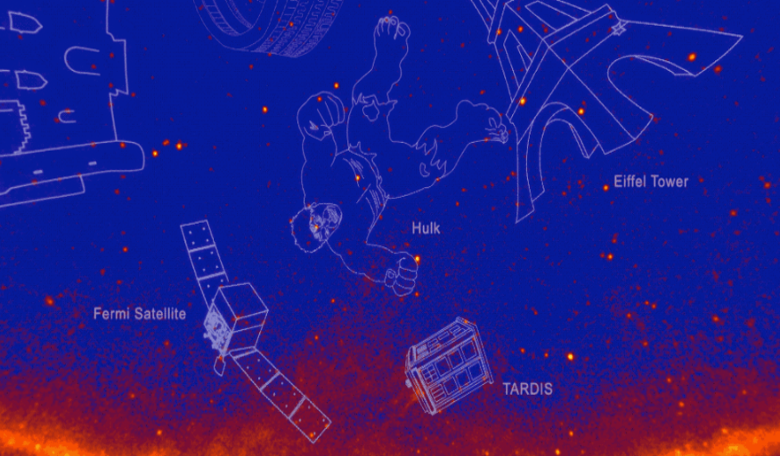While generation after generation of star gazers are accustomed to seeing the Great Bear or Orion shining bright in the night sky, it has been a very, very long time since the constellations were given a make-over. Over half of the 88 traditional constellations that mark out creatures and heroes of mythology in the skies came from the ancient Greeks, and they based their knowledge upon the earlier works by the ancient Babylonian, Egyptian and Assyrian.
So, wouldn’t it be great to look up at the night sky and see a group of stars that loosely resemble the Hulk for example.
Well, now you can. Sort of. Although you may not be able to see them with the naked eye, scientists working with NASA’s Fermi Gamma-ray Space Telescope have mapped out 21 new constellations from gamma-ray sources based on characters and famous objects with a science, or science-fiction theme to mark Fermi’s 10th year of operations.
“Developing these unofficial constellations was a fun way to highlight a decade of Fermi’s accomplishments,” said Julie McEnery, the Fermi project scientist at NASA’s Goddard Space Flight Center in Greenbelt, Maryland. “One way or another, all of the gamma-ray constellations have a tie-in to Fermi science.”
Among the assortment of new constellations are the time-travelling TARDIS from “Doctor Who,” Godzilla, Albert Einstein, the original flagship from “Star Trek: The Original Series,” the U.S.S. Enterprise and yes, the Hulk. Given that the green superhuman is the product of a gamma-ray experiment gone wrong, it is only right that he should be given a place among the stars.
The collection also includes the Black Widow Spider. Although normally associated with a small, dark-coloured but deadly arachnid, this particular version is named after a class of binary pulsar that are menacing for another reason; they have a tendency to devour their companion star.
Like the Black Widow pulsar variety, all of the objects that contribute to the new constellations are from gamma-ray sources, such as supermassive black holes, gamma-ray bursts and the debris of supernova explosions. Finds that are part of the 3,000 new discoveries clocked up by Fermi since its launch; that is 10 times the number known before the mission started.
“For the first time ever, the number of known gamma-ray sources was comparable to the number of bright stars, so we thought a new set of constellations was a great way to illustrate the point,” said Goddard’s Elizabeth Ferrara, who led the constellation project.
And the telescope is still going strong, as a new all-sky Large Area Telescope (LAT) catalogue is currently being prepared that will add a further 2000 sources to the collection.
These additional gamma-ray sources could one day end up as another set of constellations, but for now if you want to see, amongst others, the Washington Monument, Schrödinger’s Cat and Mount Fuji in Japan depicted in the sky as points of the highest-energy light in the Universe, then go here to visit Fermi’s web-based interactive display.











